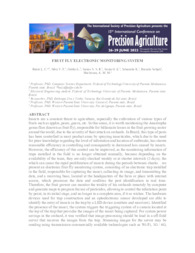Fruit fly electronic monitoring system.
Fruit fly electronic monitoring system.
Author(s): BAZZI, L. C.; SILVA, V. F.; GEBLER, L.; SANTOS, S. S. R.; SOUZA, G. E; SCHENATTO, K.; SOBJAK, R.; HACHISUCA, A. M. M
Summary: Insects are a constant threat to agriculture, especially the cultivation of various types of fruits such as apples, pears, guava, etc. In this sense, it is worth mentioning the Anastrepha genus flies (known as fruit fly), responsible for billionaire losses in the fruit growing sector around the world, due to the severity of their attack on orchards. In Brazil, this type of pests has been controlled in most product areas by spraying insecticides, which due to the need for prior knowledge regarding the level of infestation and location of outbreaks, has shown reasonable efficiency in controlling and consequently in decreased loss caused by insects. However, the efficiency of this control can be improved, as the monitoring information of traps installed in the field is no longer obtained manually, because depending on the availability of the team, they are only checked weekly or at shorter intervals (3 days), the which can cause the rapid proliferation of insects during the periods between checks. . we present an electronic fruit fly monitoring system, consisting of an electronic trap installed in the field, responsible for capturing the insect, collecting its image, and transmitting the data, and a receiving base, located at the headquarters of the farm or place with internet access, which processes the data and confirms the pest identification in real time. Therefore, the fruit grower can monitor the totality of his orchards remotely by computer and generate maps to program the use of pesticides, allowing to control the infestation point by point, in its initial stage, and no longer in a complete area, if it so wishes. The hardware devices used for trap construction and an optoelectronic sensor developed are able to identify the entry of insects in the trap by a LED device (emitters and receivers). Identified the presence of the insect, the system triggers the triggering system of a camera located at the top of the trap that provides the images of the insect being captured. For system power savings in the orchard, it was verified that image processing should be load in a off-field server that receives the images from the trap. Streaming images for the server may be sending using transmission commercially available technologies such as Wi-Fi, 3G / 4G, or Zegbee, depending on area characteristics and network availability. Through the obtained and processed images, it was possibility recognize the insect species through of its wing patterns, avoiding false positive occurrences. The system is being tested in apple orchards in southern Brazil.
Publication year: 2022
Types of publication: Paper in annals and proceedings
Unit: Embrapa Grape & Wine
Keywords: Electronic monitoring system, Fruit fly, Mosca das Frutas
Observation
Some of Embrapa's publications are published as ePub files. To read them, use or download one of the following free software options to your computer or mobile device. Android: Google Play Books; IOS: iBooks; Windows and Linux: Calibre.
Access other publications
Access the Agricultural Research Database (BDPA) to consult Embrapa's full library collection and records.
Visit Embrapa Bookstore to purchase books and other publications sold by Embrapa.

